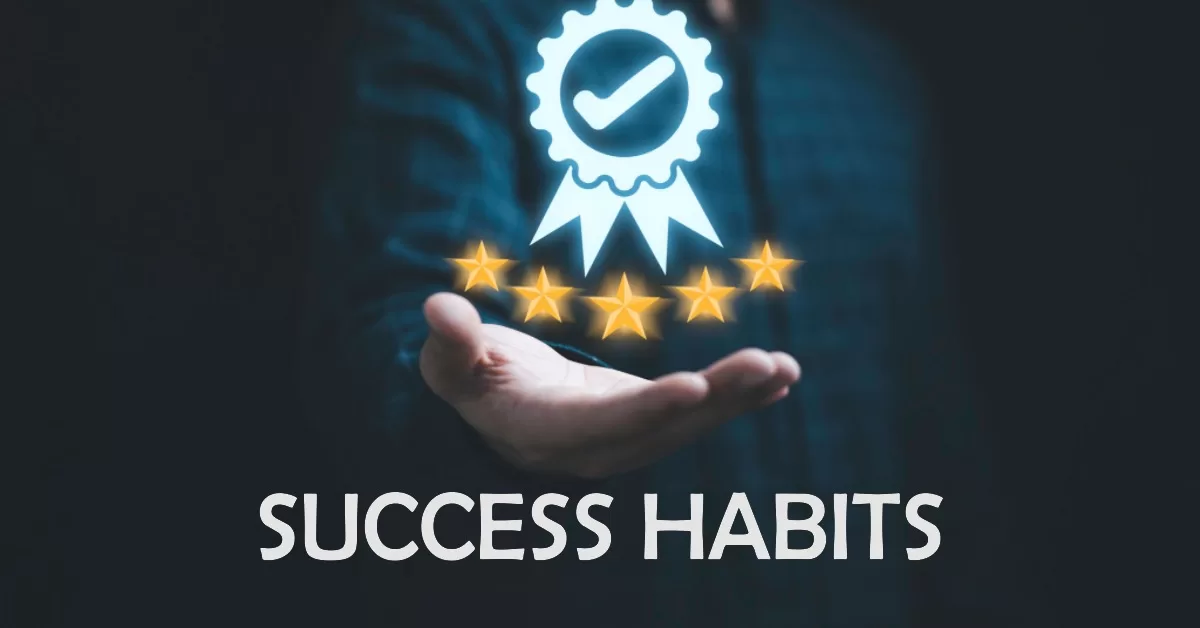Habits are a common part of our everyday lives, and they can have a significant impact on our mental health and wellbeing. This article will explore the benefits of developing habits for long-term mental conditioning success, as well as provide strategies to help individuals identify their goals, break them down into smaller achievable goals, and track their progress. Through this process, it is possible to create positive reinforcement that leads to more successful habit formation. Additionally, individuals will learn how to identify unhelpful habits and develop strategies for long-term success.
Table of Contents
Understand the Benefits of Habits
Establishing routines can be a significant factor in achieving sustained positive psychological results. Developing habits helps to reinforce our ability to make decisions, by creating a framework that requires us to take action when faced with choices. Habits can build resilience and enable individuals to remain focused on tasks despite external pressures or distractions. Furthermore, habits create an emotional comfort zone that allows individuals to feel secure in their decision-making process. This creates an environment of self-confidence and establishes greater control over the thought processes and actions taken throughout the day.
Habits provide structure for our daily lives, allowing us to accomplish more with less effort as we become accustomed to completing activities on autopilot. As we engage in regular behaviors, it becomes easier for us to recognize patterns and anticipate outcomes so that we can better prepare ourselves for potential changes in our lives or environment. Through habit formation, individuals are able to establish long-term goals as well as short-term objectives without feeling overwhelmed by the process of implementing them into their daily routines.
The development of healthy habits increases mental clarity and cognitive functioning by enhancing focus and concentration levels throughout the day. Establishing good practices encourages individuals to establish boundaries between work/study time and leisure time while also helping them maintain the balance between physical activity, restful sleep, healthy eating habits, social connections, spiritual practice (if applicable), etc. Also, having good habits helps promote a sense of stability which is essential during times of stress or transition since it prevents an individual from becoming overwhelmed by such events.
It is important for individuals who wish to improve their mental conditioning practice over the long term to understand how developing habits can help them achieve this goal. By investing in quality practices that bring personal satisfaction as well as tangible benefits like improved productivity or enhanced creativity, individuals can set themselves up for success both now and in the future.
Identify Your Goals
To ensure long-term success, it is essential to identify and prioritize one’s goals. Goal identification can be broken down into two parts: identifying short-term goals and long-term goals.
Short-Term Goals:
- Develop healthy habits that are easy to maintain.
- Set achievable milestones that are attainable within a short period of time.
Long-Term Goals:
- Invest in yourself by finding new opportunities for growth.
- Focus on the bigger picture and find ways to reach your ultimate goal.
Identifying realistic goals allows an individual to plan ahead and stay motivated as they work toward achieving their desired outcome. It also serves as a reminder of why these habits have been developed in the first place, which helps keep focus and commitment intact over time. On top of that, understanding what motivates a person to develop such habits can help them better understand how they can best achieve their objectives on both the short and long-term scales.
By utilizing proper goal identification techniques, people can create an effective strategy for themselves that will allow them to remain consistent with their chosen habits over the course of time while still maintaining balance in other areas of life. Furthermore, this practice allows individuals to track progress against their predetermined objectives while providing valuable insight into areas where improvement may be needed or adjustments must be made in order for future success to be achieved. Ultimately, by setting clear expectations from the outset, developing strong habits becomes much simpler and far more successful than without any form of planning or foresight whatsoever.
Set Realistic Expectations
In order to ensure a successful outcome, it is important to set realistic expectations for oneself prior to beginning any habit-forming activity. It is easy to get discouraged when we do not meet these expectations or when progress seems too slow. Unrealistic expectations can make it difficult to maintain motivation and therefore hinder our ability to form long-term habits. Setting realistic goals allows us to break down the task into smaller, achievable steps that are more likely to lead us toward success.
It is also important for individuals to be mindful of their current lifestyle and circumstances when setting expectations. An individual’s capacity for forming new habits depends heavily on their existing commitments and lifestyle choices, and it is impossible for them to expect too much from themselves if they are already overloaded with tasks or responsibilities. For example, an individual who works full time may find it difficult to commit entirely new activities such as meditation or exercise into their daily routine unless they adjust other aspects of their life accordingly.
When setting realistic expectations, individuals should focus on the process rather than the end goal itself. This encourages them to stay focused on the present moment while engaging in habit-forming activities instead of worrying about results that may be out of reach due to external factors such as limited time or resources. Furthermore, focusing on incremental progress helps keep motivation high by providing tangible evidence that effort is being rewarded over time.
Creating measurable goals and milestones provides individuals with a sense of accomplishment even if larger goals have yet to be achieved. This helps reinforce positive behavior which can eventually become part of one’s daily routine over time without conscious thought or effort required. As habits become more ingrained in our lives, we become better able to adapt quickly and effectively respond in times of stress or challenge without having fear of failure due lack unpreparedness – a trait that enables us to achieve long-term mental conditioning success
Break Habits Down into Smaller Goals
Breaking big habits into smaller pieces is an effective strategy for creating long-lasting changes in behavior. By breaking down larger goals into smaller components, it becomes easier to track and measure progress toward a goal. This approach also makes the task of forming new habits more manageable since each individual step is simpler and may require less effort or willpower to accomplish. Also, by breaking down large goals into smaller steps, it becomes easier to design rewards for completing each portion of the task; this provides both immediate gratification as well as motivation to keep working toward the ultimate goal.
The process of breaking down larger goals into small steps also has psychological benefits. The sense of accomplishment gained from achieving small milestones helps to create positive reinforcement loops which can further enhance motivation. Additionally, it prevents feelings of frustration or discouragement due to a lack of progress when trying to change behaviors that are ingrained through habit formation. Breaking down tasks into smaller pieces increases the likelihood that tasks will be completed on time and with quality results due to increased focus on detail and accuracy at each step along the way.
The concept behind this approach is known as incrementalism: making small changes over time that add up to a significant impact in the long run instead of attempting radical overhauls all at once. This encourages individuals by providing a greater sense of control over their actions since they can see progress being made bit by bit rather than feeling overwhelmed by large tasks that seem impossible due to a lack of resources or skillsets necessary for completion. This strategy also allows people to adjust course if needed should things not go according to plan, as only minor adjustments would be required instead of starting completely from scratch again every time something goes wrong or changes unexpectedly occur in life circumstances or the environment.
This technique can be applied across many different types of contexts such as developing healthier eating habits, forming better relationships with others, and acquiring new skillsets, knowledge, or abilities; any lifestyle change that requires multiple steps can benefit from breaking down large goals into smaller chunks so that progress is measurable and success within reach regardless how challenging or daunting it may appear initially upon first inspection.
Find Positive Reinforcement

Identifying positive reinforcement is a critical component of forming successful behavior changes. Positive reinforcement works by rewarding desired behaviors that are beneficial to the individual, ultimately leading to increased motivation for repetition of the behavior. This type of reinforcement encourages an individual to continue engaging in the desired activity, even if it may be difficult or uncomfortable at first. It also creates a connection between effort and reward which can help foster a sense of accomplishment when desired habits become more routine. Furthermore, positive reinforcements can encourage learning new skills as they provide an impetus for attempting something that may normally be avoided due to fear or discomfort.
There are two types of positive reinforcement: tangible and intangible rewards. Tangible rewards involve providing physical items such as food or toys while intangible rewards include verbal praise, hugs, high-fives, etcetera. Both types can be effective but should generally be used sparingly in order to avoid habituating individuals to expect rewards after every task they complete – this could lead to decreased motivation over time if individuals come to expect these rewards without putting in any effort themselves. It is important that tangible rewards do not become too large or expensive in order for them to remain meaningful but still achievable with consistent effort over time.
It is important for people to set out on developing habits to understand their own motivations and find what drives them toward success; this will aid in identifying appropriate forms of positive reinforcement which are tailored specifically to each individual’s needs and goals. For example, some may find verbal affirmations encouraging while others may need more concrete incentives such as money or days off work; understanding one’s personal motivations can help determine which form of positive reinforcement would be most effective in helping achieve long-term objectives.
Developing healthy habits requires commitment and dedication from the individual engaging in the activity; however, incorporating effective forms of positive reinforcement can offer additional support along the journey toward success and mental conditioning improvement. People must remember that forming successful habits take time so it is important not to give up after just a few attempts; instead, find ways to motivate oneself through positivity and reward systems designed specifically according to personal needs and goals
Track Your Progress
Tracking progress is an essential step in achieving desired results and can help provide insight into which strategies are working or need to be adjusted. To use this method effectively, it is important to identify the long-term goal and break it down into smaller, measurable steps (as explained before) that can be treated as trackable milestones. By tracking these steps, individuals can evaluate how close they are to their goals and make adjustments as needed. Tracking progress gives individuals an opportunity to reward themselves for accomplishments along the way. This encourages them to continue striving for success.
The following list outlines three key aspects of tracking progress:
- Identify a Long-Term Goal: Having a clearly defined goal brings focus and clarity that will guide the individual’s efforts toward success.
- Break Down Goal Into Small Steps: Creating small milestones makes the achievement more manageable and allows for continuous monitoring of progress throughout the journey.
- Provide Positive Reinforcement: Rewarding oneself for reaching a milestone provides motivation to keep going when things become difficult or overwhelming.
When tracking progress, it is important that individuals remain flexible with their plans so they can adjust according to their needs or interests as they move closer to the end goal; otherwise, they may become stuck in rigid patterns of behavior that do not yield desired outcomes over time. Furthermore, by being honest about one’s successes and failures during each step of the process, individuals gain insight into themselves which can inform future decisions made regarding mental health conditioning goals and objectives.
In order to ensure sustained success with developing habits, regular assessment of progress should be conducted alongside a periodic reflection on what has been achieved thus far in order to stay motivated while continuing on one’s journey toward their ultimate destination – long-term mental conditioning success!
Identify Unhelpful Habits
Assessing unhelpful habits is an essential step in achieving long-term mental conditioning success. In order to be successful, one must identify the behaviors that are having a negative effect on their mental health. This can be done by keeping a journal and writing down the thoughts, feelings, and behavior associated with each habit. Through this process, individuals can begin to recognize patterns of behavior that lead to unhealthy outcomes and create strategies to avoid them.
The first step in identifying unhelpful habits is understanding why they exist. It is important for individuals to reflect on past experiences or situations that may have contributed to the development of these behaviors. Once the root cause has been identified, it is possible to develop plans of action that will help prevent these behaviors from reoccurring in the future.
Another way individuals can identify unhelpful habits is through self-assessment techniques such as mindfulness meditation or cognitive behavioral therapy (CBT). Mindfulness meditation allows one to become aware of their thoughts and feelings without judgment, while CBT helps individuals recognize how their thoughts influence their behavior and take steps toward changing it. Both techniques require practice but can ultimately help individuals identify unhealthy patterns in their lives and work toward developing more beneficial ones.
Ultimately, assessing unhelpful habits enables people to make conscious decisions about how they want to live their lives moving forward. By recognizing which thoughts or actions do not support mental wellbeing, people can focus on creating new habits that will lead them closer to achieving long-term mental conditioning success.
Develop Strategies for Long-Term Success
Once the unhelpful habits have been identified, it is essential to develop strategies for long-term success in order to achieve mental conditioning goals. Developing effective strategies involves understanding how habits are formed and then applying the following four key principles:
- Establish clear goals that are achievable and measurable.
- Create a plan of action that takes into account both short-term and long-term objectives.
- Be aware of potential barriers and obstacles that may arise during the implementation of the strategy and plan for contingencies in advance.
- Set realistic timelines for achieving goals that are based on individual capabilities rather than external expectations or pressures.
Developing strategies for long-term success requires a comprehensive approach that includes self-reflection, goal setting, planning, monitoring progress, adapting plans as needed, developing accountability practices, cultivating motivation, and tracking progress over time with periodic reviews. Taking an active role in this process can help individuals identify areas where they need additional support or resources in order to succeed in reaching their goals. Also, note that it’s important to focus on creating positive reinforcement systems that will encourage positive behavior changes while identifying those behaviors that should be avoided or eliminated altogether from one’s life if possible.
In order to ensure the successful implementation of any strategy developed for long-term mental conditioning success, individuals must commit fully to the process by taking responsibility for their actions and outcomes while also seeking out necessary support when needed from family members or qualified professionals such as therapists or coaches who specialize in habit formation techniques and behavior change management processes. Finally, it is important to remember that habits take time to form; therefore patience is key as one works toward establishing new patterns of behavior over a period of weeks or months depending on individual circumstances and level of commitment toward achieving desired results.
Summary

Developing habits is an important step to achieving long-term mental conditioning success. Habits can be broken down into smaller goals and reinforced with positive reinforcement. Through tracking the progress of these goals, one may identify unhelpful habits that need to be addressed in order for long-term success. Setting realistic expectations and identifying achievable goals are key to developing successful habits that will lead to improved mental conditioning. With proper planning, execution, and dedication, individuals can successfully condition their minds for the future.




